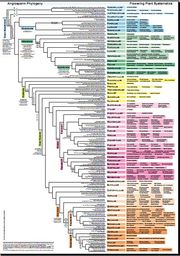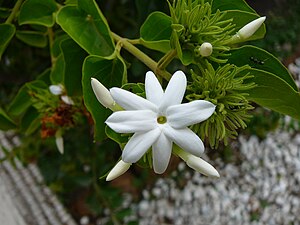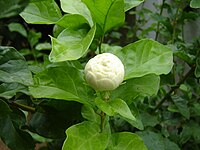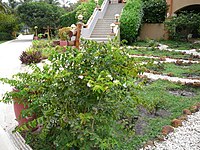Jasminum sambac
Read community contributed articles on biodiversity & environment || Cultural practices & mythological stories related to Indian biodiversity || Official documents related to environment || NGOs, Blogs and Websites || Environment-related video collection || Plants of India || Mammals of India || Facebook || Twitter
Share this page: Jasminum sambac
Jasminum sambac is a species of jasmine native to southwestern and southern Asia, in the Philippines, India, Myanmar and Sri Lanka. It is grown mainly as an ornamental plant due to its fragrant and beautiful flowers.
Click here to see all Semantic Properties associated with this page
Please note that the above slideshow is automatically created by searching Flickr and does not contain manually curated images. Hence, it is likely that some images may not be exactly of Jasminum sambac.
Click on the tabs below to know more...
- Species identity and nomenclature
- Current Wikipedia entry
- Binomial Classification
- Morphological features
- Habitat and Geographical Spread
- Maps
- Medicinal Importance
- Cultural significance
- Commercial importance and cultivation
- Summary of PubMed articles
- Summary of NCBI molecular data
- External Links
- Images and Videos
| Parameter | Value(s) | References See complete references in the References section at the end |
|---|---|---|
| Names of users who have contributed to this species page | Supriyak | |
| Date on which this page was first created | 2010/07/31 | |
| This page was last modified on: | 24 November 2010 05:10:07 | |
| Name of the species | Jasminum sambac | |
| ID on Encyclopedia of Life | 579168 | |
| Synonyms | Please check Binomial Classification section for synonyms. | |
| Common English Names | Jasmine | |
| Common Hindi Names | बेला Bela, मोतिया Motiya, मोगरा Mogra | |
| Common Indian names | Bel (Hindi); maligai (Tamil); Jati (Manipuri); Mogra (Marathi); Mallikā (Sanskrit); Mallepuvvu (Telugu); Mallikaipu (Tamil); dundu Mallige (Kannada); Kaliyan (Urdu) | EOL, Wikipedia |
| Origins/Meanings of the common names | The botanic name sambac is derived from a misapplication of the Sanskrit name champaka, which refers to the fragrant flowered shrub Michelia champaca. The name Jasmine is derived from the Persian Yasmin meaning Gift from God. Jasmine flowers are used in many religious occasions as offerings to Gods. | Wikipedia |
Taxonomy from Encyclopedia of Life
If nothing is displayed in this section, it means the EoL ID has not been defined. Please click on Edit with form button on top and follow the instructions for filling in the EoL ID
{{#EoLOnlyHierarchy:579168}}
Taxonomy filled in form

Click here for the PDF of the phylogeny
| Taxon | Value |
|---|---|
| Regnum (Kingdom) | Plantae |
| Division | Magnoliophyta |
| Class | Magnoliopsida |
| Order | Lamiales |
| Family | Oleaceae |
| Genus | Jasminum |
| Source of data | Encyclopedia of Life |
| ||||||||||||||||||||
| Division | Taxon details | Taxon morphology details |
|---|---|---|
| Magnoliophyta | Also called Angiospermae. The ancestors of flowering plants diverged from gymnosperms around 245–202 million years ago, and the first flowering plants known to exist are from 140 million years ago. They diversified enormously during the Lower Cretaceous and became widespread around 100 million years ago, but replaced conifers as the dominant trees only around 60-100 million years ago. | These are seed plants like Gymnosperms, but can be differentiated by the presence of flowers, seeds containing endosperm and seeds that produce a fruit. Angiosperms are the most diverse and highly evolutionarily successful group of land plants. |
| ||||||||||||||||||||
| Class | Taxon details | Taxon morphology details |
|---|---|---|
| Magnoliopsida | Magnoliopsida is the scientific name for dicots. This class contains about ~1,99,350 species of Angiosperms. Eudicots are a subset of Dicots. Based on chloroplast DNA sequences, the divergence date between monocots and dicots is estimated to be ~200 million years, with a 40 million years uncertainty. | Dicots are diverse in habit, with half of all the species being more or less woody-stemmed - a reflection of the usual presence of a vascular cambium in the class. Annuals, biennials, vines, epiphytes, aquatics, parasites, and saprotrophs are also well represented in dicots. Vascular bundles of the stem are usually borne in a ring that encloses the pith. Vessel elements present except in some putatively primitive woody or aquatic families. Most dicots have a primary root system derived from the radicle, although some have an adventitious root system commonly seen in the class of monocots. Cotyledons are usually 2, seldom 1, 3, or 4. Leaves are mostly net-veined. |
| ||||||||||||||||||||
| Order | Taxon details | Taxon morphology details |
|---|---|---|
| Lamiales | Species in this order probably arose ~70-100 million years ago based on various estimates. Lamiales contain ~12% of eudicot diversity. Well-known or economically important members of this order include lavender, lilac, olive, jasmine, the ash tree, teak, snapdragon, sesame, psyllium, and a number of table herbs such as mint, basil, and rosemary. | Members of this species are herbaceous or shrubby, have mono-symmetric flowers and numerous small seeds. Species in this order typically have the following characteristics, although there are exceptions to all of them - 1) superior ovary composed of two fused carpels 2) five petals fused into a tube 3) bilaterally symmetrical, often bilabiate corollas and 4) four (or fewer) fertile stamens |
|
|
Based on classification
More details can be found in the Binomial Classification section.
Morphology from Encyclopedia of Life
If nothing is displayed in this section, it means the EoL ID has not been defined. Please click on Edit with form button on top and follow the instructions for filling in the EoL ID
{{#EoLOnlyDescription:579168}}
General morphology
| Parameter | Value(s) | References See complete references in the References section at the end |
|---|---|---|
| General morphological features of the plant | Evergreen Shrubs erect or scandent, to 3 m. Branchlets terete or slightly compressed, sometimes hollow, sparsely pubescent. | Encyclopedia of Life |
| Seed dispersal mechanism | Entomophily (By insects) | |
|---|---|---|
| Bloom type | Perennial | Flowers of India |
| Life cycle of the plant |
How to identify this species
For a detailed description, refer to the General Morphology details above
| Parameter | Value(s) | References See complete references in the References section at the end |
|---|---|---|
| Type of plant | Woody (Tree/Shrub) | |
| Plant height | 6 feet to 10 feet | EoL |
| Flower color | White | Wikipedia |
| Flower shape | ||
| Floral symmetry | ||
| Phyllotaxy of leaves | Opposite | |
| Leaf shape | Elliptical | |
| Is the leaf petiolated or sessile? | ||
| Is the leaf simple or compound? |
| Parameter | Value(s) | References See complete references in the References section at the end |
|---|---|---|
| IUCN Conservation Status | Not Evaluated | |
| Indian States in which the species has been documented | Sasya Sampada | |
| Locations at which the species has been documented | ||
| Biotic zones inhabited | West Coast | Plants of India |
| Details about the habitat | cultivated,Cultivated fields,Cultivated fields and Plains,cultivated in gardens,Decidious forest,dry mixed forests,Escape,forest edges,Gardens,Gardens and Roadsides,House gardens,Plains,River Banks,Sandy scrup jungles,Temple gardens,Tropical regions,Undergrowth,Undergrowth forests,waste land,Wild | Plants of India |
| Is this species native to India? | Yes | Flowers of India |
| Is the species indigenous/endemic to Sub-Himalayan regions? | ||
| Is the species indigenous/endemic to Western Ghats? | ||
| Is the species indigenous/endemic to Eastern Ghats? |
More plants native to India
| ||||||||||||||||||||||||||||||||||||||||||
If no maps are displayed below, it means the required data is absent. Click on "Edit with form" button on top of the page to add this information.
| Parameter | Value(s) | References See complete references in the References section at the end |
|---|---|---|
| Does this species have any medicinal use? | Yes |
|
Other plants of the same family having medicinal use:
|
| Parameter | Value(s) | References See complete references in the References section at the end |
|---|---|---|
| General types of ailments this species is used for treating | ||
| Specific ailments for which the species is used | congestive headache, sore eyes, fever, skin complaints and ulcers. | Sasya Sampada |
| Medicinal systems which use this plant | ||
| Details of Medicinal use | ||
| Parts of the plant used for treatment | Root, Leaves, Flower | Sasya Sampada |
| Names of some medicinal active compounds in this plant, if known. | ||
| Details of the active chemical compounds found in this plant | ||
| Is the molecular basis of the medicinal action known? | ||
| Details of molecular basis of action | ||
| Are the toxic effects of consumption of this plant known? | ||
| Details of the toxic effects of the plant species | ||
| Have there been validation/clinical studies related to this plant? | ||
| Details of the clinical studies related to the plant species |
| Parameter | Value(s) | References See complete references in the References section at the end |
|---|---|---|
| Is this plant/plant-derived product used in food preparations? | Yes | User-reported |
| Part(s) of the plant used in the food preparations | Flower | |
| Details of use in food preparations | Used to flavor tea,water. | |
| Does this species have any religious significance? | Yes | User-reported |
| Religions which mention/give significance to this species | Hinduism, Buddhism | EoL |
| Religious occasions | Hindu Puja | Supriyak |
| Details of religious use | Jasmine flowers are used in many religious occasions as offerings to Gods. Garlands made from Jasmine flowers, as shown above, are adorned by women during special occasions. | Wikipedia,Supriyak |
| Parameter | Value(s) | References See complete references in the References section at the end |
|---|---|---|
| Is this plant cultivated commercially in India? | Yes | Sasya Sampada |
| Uses for which the plant is commercially cultivated | Human consumption, Ornamental use | Sasya Sampada |
| Plant parts of commercial value | ||
| Products where this plant is used | User-reported | |
| Description of use | Flavouring agent: to flavour tea in China, Making Perfumes,for making garlands and bouquets and for religious offerings. | Sasya Sampada |
| States where this plant is cultivated commercially | Plants of India | |
| Best period for planting this plant | ||
| Best period for harvesting this plant | Summer, Monsoon | |
| Method of propagation | Seeds | Sasya Sampada |
| Water requirement of this plant | ||
| Pests and Diseases affecting this plant during cultivation | ||
| Other considerations while cultivating this plant | It can be grown in a variety of climate and soils. Generally, it prefers mild tropical climate for proper growth and flowering. Mild winter, warm summer, moderate rainfall and sunny days are ideal climatic requirement. Loamy garden soils are best-suited for cultivation of all species and varieties. With liberal application of manure and assured water supply, jasmines can also be grown suitably in sandy soils. In clayey soil, flower production is hampered to a great extent. This type of soil can be improved by adding lime and applying organic manures.
Pests: J. sambac is often attacked by scale insects, resulting in black fungal growths on leaves. The larvae of jasmine fly, a cecidomyiid, cause considerable damage to buds. Spraying with Parathion (0.025%) with Sandovt as adhesive checks the pest to a consider-able extent Diseases - Nematode and root rot are the major diseases attacking the jasmine crop. |
Plants of India, Agrohortico,Keralaagriculture |
Pubmed Word cloud
This word cloud is obtained using the tool LigerCat by searching the Pubmed database. LigerCat builds the cloud from the most relevant Medical Subject Headings (MeSH) terms. Each term's relative size indicates how many times it appears in the PubMed search results. Click on a term to access the full LigerCat cloud, with live PubMed search capabilities. LigerCat has been developed for the Biology of Aging Project.
The page may take some time to load since LigerCat is searching the entire PubMed database and sending us the results in real time.
- If there is an error message below, it means that there is no retrievable information available on NCBI
- If the number of nucleotide sequences is less than 100, very little genomic work has been done on this species. A respectable number of nucleotide sequences is above 10000.
- Most of the nucleotide sequences may come from three sources:
- Studies on single genes, where people try to sequence genes such as some specific dehydrogenases important,say, for tannin production
- Sequences of Ribosomal Internal Transcribed Spacer, whose sequence is used for generating molecular phylogenetic trees to establish species relationships
- Expressed Sequence Tags (ESTs) which can tell about which genes are present and expressed in the species at a particular time in the given tissue
{{#queryDB:taxonomy |Jasminum sambac }}
| Parameter | Value(s) | References See complete references in the References section at the end |
|---|---|---|
| Details of modern scientific knowledge available for this species | ||
| Are herbarium specimen available for this species? | ||
| Institutes having herbarium samples |
If nothing is displayed in this section, it means the EoL ID has not been defined. Please click on Edit with form button on top and follow the instructions for filling in the EoL ID
{{#EoLOnlyAdditionalInfo:579168}}
References
Agrohortico (Web): Cultivation, Accessdate=2010-July-31
Keralaagriculture (Web): Diseases, Accessdate=2010-July-31
| This article is a stub. You can help Project Brahma by expanding it. |


